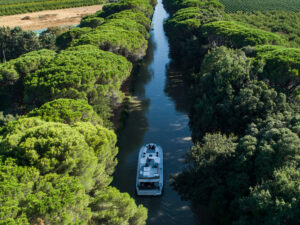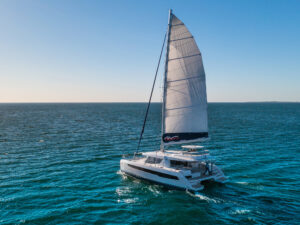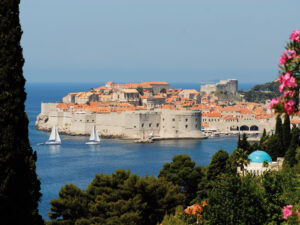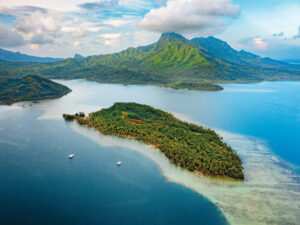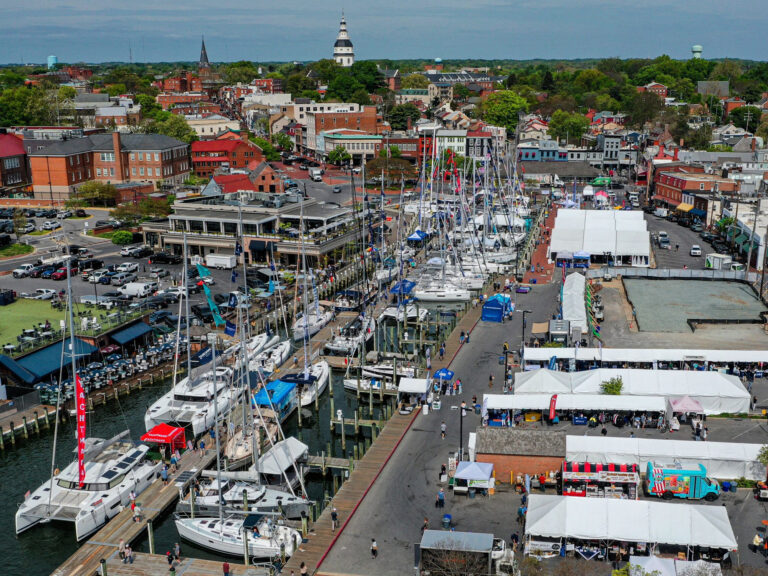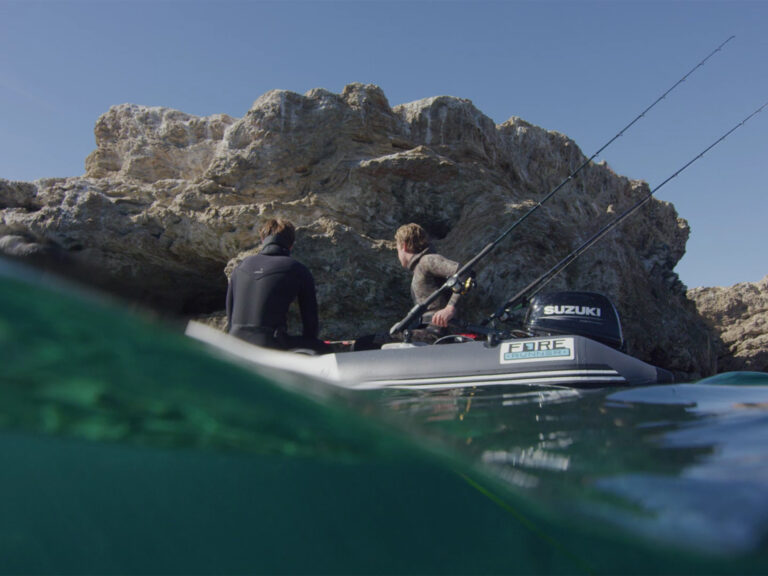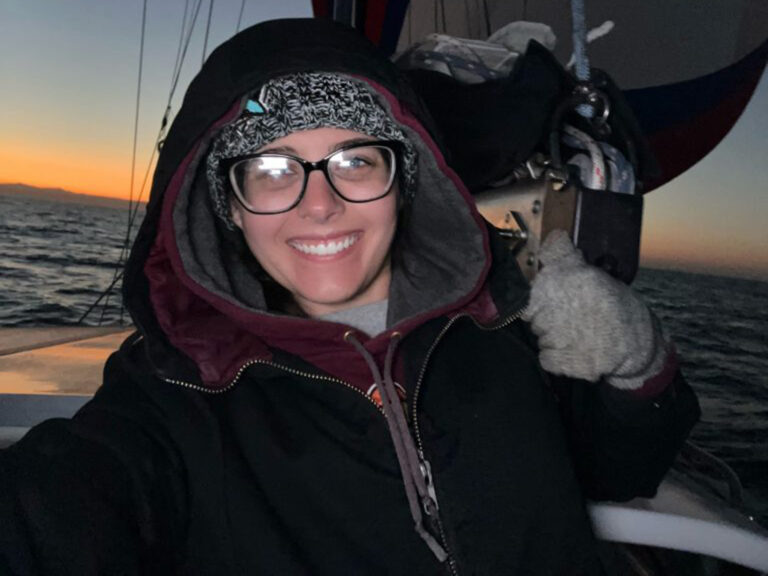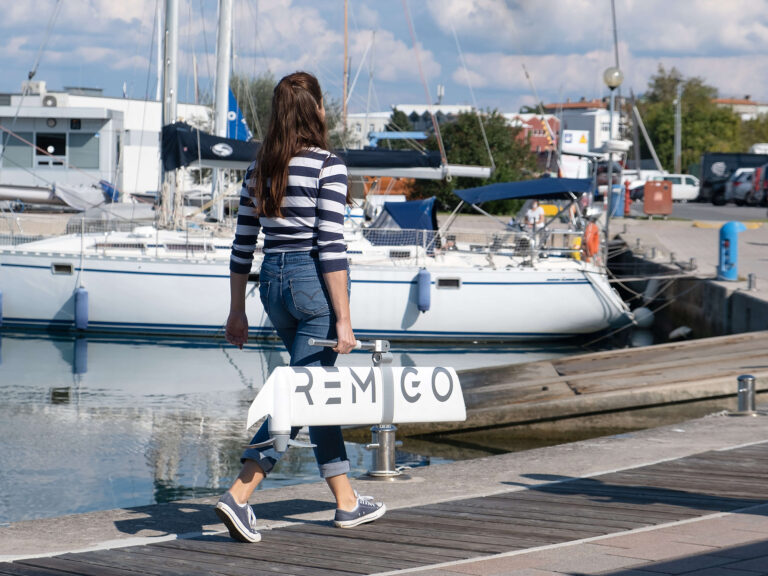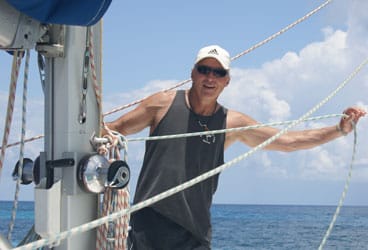
Courtesy of Andrew Hughes| |When pushed to the edge, the navigator blew off steam with a few cool Belikins-and tunes.| On any journey to any destination anywhere in the world, there are precisely two types of travelers involved. One kind is intrepid and outgoing, eager to grasp and savor new experiences and to leap headlong into the deep end of mysterious pools. These bold souls are called adventurers, explorers, and lovers of life.
People like me.
Then there are those who find that the very best parts of an action-packed escapade are the long naps between those tense, avoidable moments when something is actually happening. These timid, inward-peering individuals might also be referred to as wimps, wussies, and bores.
People like my old pal Angus Phillips.
OK, admittedly, that’s putting way too sharp a point on it. Ango is actually a very fine sailor and perhaps an even better hunter and fisherman. As the long-time outdoors writer for The Washington Post, he’s plied those various pastimes all over creation with the likes of presidents, poets, and paupers.
But at the outset of our wanderings in Belize, when “cruise director” and this rag’s deputy editor, Elaine Lembo, suggested an inaugural inland journey to take in a traditional Mayan ceremony set within the remains of a stirring ancient temple, a side trip she believed would present us all with a rare opportunity to drink in the rich, cultural heritage of this endlessly fascinating Central American nation, Angus (and his Chesapeake Bay cohort, Andy Hughes) basically said, “Pass.” He’d had, like, you know, a long flight down. (He did, however, volunteer to put plenty of beer on ice while we were gone, and so it was that I wasn’t completely opposed to his intransigence.)
So Elaine and I took off on a daylong jaunt through mangrove waterways and rugged overland terrain by skiff, four-wheel-drive, and foot to the annual Deer Dance at the Lubaantun Archaeological Reserve, in the nation’s remote cacao-bean region, an exercise that in itself turned out to be colorful and entertaining. But it ended up that a side trip to the main event proved to be the thing that I’ll always remember about the day. (And really, that’s the true reward of travel, when you take a chance and happen upon something unexpected and unreal that you’ll savor forever. Are you listening, Angus?)
It wasn’t the tarantula our guide coaxed with a stick from a hole in a tree trunk on the hike up the banks of the Blue Creek River that was unforgettable, but the dark, forbidden-looking cave at the end of the trail. Truthfully, caves have always given me the claustrophobic creeps, but when our escort peeled down to his swim trunks, handed me a flashlight, and suggested I follow him into the watery tomb, for some strange reason, I immediately jumped in and followed his command.
We swam and waded forth, in turns, up around a bend and then deeper into the oh-so-dark cavern. Finally, looking back from a few hundred yards in, there wasn’t the slightest trace of natural light visible. “On the count of three,” said the guide, “flashlights off.” He paused. “One. Two. Three.”
Click.
The world was a complete and total blank: It was impossible to tell if your eyes were open or shut, a sensation that was both terrifying and exhilarating. And for me, it set the absolute tone for everything that followed, starting the very next day, when we set sail from Placencia on our Moorings 4000 catamaran, Lisa Michelle. We were out of the darkness and into the light.
There’s an old saying that the Inuit have 16 different words for “snow.” In Belize, the locals must have at least as many for “blue,” for in the clear, clean waters-and with a fresh appreciation for the play of light upon them all-it seemed like there were multiple, even endless, takes on the theme: azure, indigo, turquoise, sapphire, cobalt, lazuline, cerulean, navy. It was a veritable feast of blueness, and I couldn’t swallow enough of it.
Of course, the primary reason for those countless shades of blue is that the waters in Belize can rapidly trend from very deep to very shallow to nothing at all. Somehow, I drew the short straw and earned the dubious job of navigating, at least on the inshore part of the trip before we picked up our mandatory guide for charterers exploring outside the long barrier reef, a natural wonder that makes cruising in Belize such a singular experience. Actually-and ironically-in some ways it’s easier to navigate outside, in the deep-blue sea, where the passes are better defined and the cays and spoils less random and ubiquitous.
Heading north, we had a decent sail up the Inner Channel before picking our way through the hazards to Southwater Cay. (Image: Angus, up forward on lookout, shouting incomprehensibly into the breeze while gesticulating madly like an aircraft-carrier signalman bringing home an F-18.) But the lad can cook, among his many other talents, and he soon had a spicy pot of rice and beans going that would become an onboard staple all week long.
All of our party had traveled to Belize to enjoy the sail and one another’s company, but we’d also each come with an individual wish list to customize the occasion. Andy and Angus were after fish; Elaine, the solitude of a sunset paddle. For me, the reef was calling, and I was longing to don the scuba gear and have a big look around.
Jimmy Westby, the Belizean guide we picked up on Tobacco Cay, reckoned the ideal spot to satisfy all our desires was Glover Reef, an 18-mile-long enclosure a couple of hours offshore that once served as a lair for pirates. As we approached the reef’s southern flank to the sight of a score of frigate birds wheeling overhead, Westby, his two index fingers some two feet apart, said, “Yellowfin tuna. You see those birds, there’s tuna here. We’ll troll this bank tomorrow.”
At almost the same instant, there was a strike on the rod that Andy was trolling astern, and he yelled to me, “Grab that and start reeling!” I did as instructed, for about four spins, before the light tackle parted and that was that. “How does it feel getting schooled by a 20-pound kingfish?” he laughed. Well, crummy. An indifferent angler on the best of days, I was happy to check “fishing in Belize” off my bucket list.
Once the hook was down and the boys loaded up the dinghy with enough gear to bag Moby Dick-you need all that stuff for bonefish?-I commandeered the kayak in search of a dive shop at the Isla Marisol Resort. One tip for sailors looking to dive on a Belize charter: Bring your mask and snorkel and forget lugging anything else with you; there’s a dive operation on practically every isle, cay, and spit of sand that will be more than happy to rent you equipment.
In a windswept open-air bar at the end of a long pier, I met one of the resident dive masters, a fetching young lady by the name of-I’m not making this up-Kitty Kat. Kitty and her husband, Chad, would be running three dives the next day for a boatload of resort divers, and I was more than welcome to join the party.
Though I love diving, I’m an infrequent practitioner, and it generally takes me a dive or two before I begin to get comfortable with my surroundings and cease sucking air like a bellows. And so it was off Glover. The first dive, in a fair bit of current on a site called Grouper Gulch, was practically over before it started. On the second, along a stretch named Spanish Bay, I started to relax and enjoy the scenery. By the third, hovering over a seemingly endless drop-off, Middle Cay Wall, I finally felt as one with the elements, and at last I was able to truly drink in and appreciate the remarkable undersea world to which I’d descended.
There were squirrelfish and white-spotted files, big sea turtles, and loads of grouper. But the unparalleled stars of the show were the brilliant, crystalline waters and the sensational coral, rich and abundant and in every shape and description. On one hand, my sole day of diving in Belize barely scratched the itch; indeed, on Glover alone, the dive sites within easy access from Isla Marisol number over 20-and that’s not even counting the famous Blue Hole, offshore at Lighthouse Reef, and the Turneffe Islands. But on the other, it made a memorable trip much more so and stoked the fire to again get back below the surface, into that quiet, glimmering, unparalleled place, as soon as possible.
From Glover, we headed south toward Queen Cays Pass, where we’d cut back inside the reef and deposit our guide before continuing farther on to tiny Ranguana Cay, once again in full bareboat mode. It’d been good having Jimmy Westby aboard, a true local waterman whose stories and insights about life on the reef added texture to the journey.
But to be honest, having a guide aboard also subtracted something from the equation, an unexpected revelation that I wasn’t at all aware of until we dropped him ashore. His presence made me, well, lazy, and that’s not at all why I go to sea.
As much as I kid my amigo Angus, in lots of ways he and I are cut from the same cloth. In fact, we set sail for many of the same reasons: to be engaged with and challenged by the sea and the elements, and to share those moments, under way and at anchor, with good friends and shipmates. When you bring a stranger into the mix, even as fun and capable a soul as Jimmy Westby, it alters the dynamic of the entire enterprise. Specifically, it makes me want to take a long nap. And I guess you know how I feel about naps.
So when we settled in behind the low-slung scrap of coral otherwise known as Ranguana on our last night out, and the sky grew gray and the wind started to hoot, it was all just fine. For once again, for better or worse, we were masters of our domain-there was no one to turn to besides one another. And when the rain started to slash in sideways and the breeze continued to build, as strange as it may sound, I couldn’t have been happier. Only later would we find out we’d been lashed by the tendrils of the season’s first named tropical disturbance, a feisty, precocious little devil that blew into the western Caribbean as Pacific Tropical Storm Alma, intensified as it met local anomalies, and became Atlantic Tropical Storm Arthur.
Along with the darkness and the light, that’s the other thing I’ll always remember about our adventure in Belize: the night of the big storm, and the folks I cherish, with whom I shared it.
Herb McCormick is a CW editor at large.
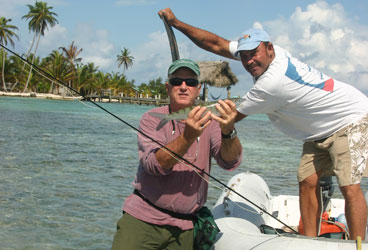
Courtesy of Andrew Hughes| |What saved the trip for Angus (left), the well-traveled outdoorsman? A ride to the shallows with Jimmy Westby and the chance to bag the so easily spooked bonefish.|
Cranky? No Way!
You have to be kidding! I cooked, I sang, and I
caught fish!
By Angus Phillips
All right, I’m not going to sugarcoat this. Belize is a fine place, warm and breezy in Northern Hemisphere winter and dotted with picturesque cays where the natives speak lovely, lyrical English. Rice and red beans and fresh fruit and veggies are cheap and plentiful. Belikin and Lighthouse, the local beers, go down smoothly, and even the beleaguered U.S. dollar is worth a gratifying, government-guaranteed two of theirs.
Fishing and diving are good to fantastic, depending on how hard you’re willing to push it, and if you like kayaking, there are cuts and backwaters and marshes to poke around in. But this is a sailing magazine, right? Well, caveat emptor and all that, and I’m giving you the caveat right up front.
Belize has a lot of rocks and reefs and shallow water, which isn’t what this particular Popeye considers the makings of ideal sailing conditions. Call me crazy, but when I put the sails up and the rail down, I like to think that we’re going to keep going and not come to a cataclysmic cropper on some crash-tested coral outcrop. Capiche?
When four of us took a busman’s holiday last spring in Belize on a Moorings charter out of Placencia, I didn’t know quite what to expect. My previous Central America experiences were along the Pacific coastline of Costa Rica, where the depth falls from sandy beach to mile-deep blue water a mile or so offshore. No worries there, mate, beyond the possibility of bumping into a whale.
Belize? The contrast could hardly be starker. The entire 150-mile length of this small nation just south of Mexico’s Yucatan Peninsula is protected by a slender coral reef that meanders along from one to 25 miles offshore. This reef, the largest living one in North America, shields the waters inside from the Caribbean and its storms, and the protected patch is as pretty as a picture, dotted with mangroves and coconut palms, beaches, and gin-clear bonefish flats.
But the downside of all that was evident even before we set out on one of the two dozen charter boats that The Moorings keeps in Placencia. The base manager, co-owner Renee Brown, ran down a litany of potential perils at the pre-charter briefing that was so extensive that I found myself at one point muttering out loud, “I’m not going!”
It wasn’t just rocks and reefs-it was mosquitoes, boa constrictors, stinging anemones, Portuguese men-of-war, bad holding ground, outboard-stealing Hondurans, crocodiles, no-see-ums, tropical storms, barracudas, dragging anchors, and on and on.
One thing she was adamant about was The Moorings’ ban on going outside the big reef without a local skipper, which meant no unsupervised visits to the three coral atolls that lurk in deeper water: Lighthouse Reef, the Turneffe Islands, and Glover Reef. The concern, she said, wasn’t about charterers getting out there but about them getting back in through unmarked cuts that could easily be misread by the uneducated.
Well, there’s a tool for every problem. We managed to get to the islands by unleashing the might of the credit card and hiring a skipper for two days, who met us en route. But that’s getting ahead of the story.
First, we needed to get our own sea legs, which seemed fairly unchallenging, given the relative experience of the crew. I’m an old offshore hand, and so is Cruising World editor at large Herb McCormick, who was just back from delivering a big sloop from Baja, Mexico, to California. Elaine Lembo is the current CW deputy editor, and she’d worked seven years in the charter trade, so she should know a thing or two. Andy Hughes, our fourth, is a hard-charging racing skipper from Annapolis, Maryland, and my frequent fishing and bird-hunting partner.
The big question in a crowd like that is who’s the boss? I had the age, Herbie had the experience, Andy had the skills, and Elaine had the American Express card. Case closed. I got to cook, Herb got to navigate, Andy got to drive, and Elaine, well, Elaine called the shots.
Which was no small assignment. All of us had agendas. Herb wanted to spend some quality time sucking compressed air 80 feet down while staring at the bug-eyed creatures that dwell there. Andy and I were armed to the teeth with fly rods and saltwater flies to do battle with the wily, wary Belizean bonefish. Elaine had some weird fixation with a little red sit-upon kayak she’d had strapped to the bow rail.
With all those recreational baubles dancing in our dreams, we set forth from the harbor at Placencia into brisk headwinds that would dog us from embarkation to debarkation, which is to say the whole bloody time. “Northeast wind!” said Herb the navigator, eyeing the masthead fly on our 40-foot catamaran. It was pointing straight at our waypoint, Southwater Cay, 20 miles away. “With our luck,” he continued, “it’ll be southwest and right on the nose when we get ready to come back.” Oooh, I wish he hadn’t said that. . . .
So we motorsailed most of the day in relatively open water, managing an hour or two of genuine sailing with the jib rolled out when the breeze shifted to an acceptable slant. But the big excitement came with all sails down and furled, as we picked our way through a minefield of reefs in the Blue Ground Range to get the last few miles into Southwater Cay, where a mooring ball lay waiting.
“Nervous navigator,” Herb said of himself as he dashed in and out of the cabin, checking bearings and compass courses against the GPS. I was posted up on the bow to scan for obstacles, and I began flapping my arms and gibbering incomprehensibly anytime the bottom surged up to six feet or less in dicey spots. “Turn around!” Herb shrieked at me from the cockpit. “I can’t hear you!” But if I turned around, of course, I couldn’t see the bottom.
Little moments of tension like that only ensure that the Belikins taste sweeter once the hook is down (or the mooring ball picked up). Anyway, by cocktail time I had a pot of red beans bubbling, white rice ready to cook, a chicken cut up, and the evening’s barbecue to organize for everyone.
Such moments of homey bliss bring out the best in The Moorings’ cruising catamarans, with their roomy saloons and cockpits, spotless galleys, CD players, sofas, awnings, and expansive private staterooms for all. Really, where else in all yachting can you find a 40-footer with a big ol’ double bed and a fan, a reading light, and a pile of pillows to escape to when the conversation starts to falter? And where can you sleep better than on a big, square boat that’s safely moored while the trade winds wash over you and your belly is full of beans?
Two other Moorings cats spent the night on the hook there, but the most interesting craft by far swooped in under full sail just before dusk. The shapely wooden native vessel of about 25 feet with a great long boom and short mast was handled expertly by a staggeringly excessive crew of a dozen or so young men who tossed twin anchors out and settled down for the night. Where would they all sleep?
It wasn’t till the next day, when we picked up our local skipper, Jimmy Westby, at neighboring Tobacco Cay that we learned what the little yellow sloop was all about. “Those guys catch fish and conch,” he said. “They always sail, if they can, to save gas.”
We were to see several more such craft on our travels, each peopled by the same amazing array of strong guys who spent their days handlining for grouper and snapper or diving for conch from tiny one-man canoes, then paddled back to the mother ship at day’s end to clean the catch, eat, and sleep. Jimmy said they stayed out as long as two weeks and packed 1,200 pounds of ice aboard to keep the catch fresh.
And you think you have a hard life?
None of us was used to having a professional skipper aboard, but Westby was a welcome addition: a good boat handler, excellent company, and a fine storyteller with a wealth of local knowledge, having lived in Belize all his life. He poked the bow of our Moorings 4000 catamaran, Lisa Michelle, out the cut at Tobacco and made tracks upwind (motoring, of course) for Glover Reef. It felt nice to have somebody else in charge. Even the navigator put his feet up.
Our crew’s multiple agendas would come to an amicable head the next day at Isla Marisol, when Herb went off diving with the world’s cutest instructor; Andy and I went looking for bonefish on the flats with Jimmy in the inflatable dinghy, and Elaine attempted a circumnavigation of the tiny islet by kayak.
Everyone was down below hugging their pillows, resting up for the big day, when the twin diesels roared to life at 5:20 a.m. Whaaaa?
“Gotta catch dinner,” said Jimmy, who was already picking up the anchor. As the sun’s first rays broke in the east, he piloted us around coral heads to the place called The Wall, where Glover Reef falls into the deep abyss. He set out a single, plastic squid lure on a trolling line and tracked along the edge of the drop-off. Bang! The first fish was a barracuda, 15 pounds. Next came a king mackerel, same size, which flopped on deck to be hacked into steaks for the charcoal grill. Andy and Elaine grabbed poles, too. Three more barracuda rounded out the outing, and we were back on the mooring ball at 7 a.m., when Herb finally appeared, wiping sleep from his eyes. “My kind of fishing,” said he.
Herbie needed his beauty rest, as he’d spend the rest of the day trying to catch up with the aforementioned cute dive instructor. Meantime, Andy and I, with an assist from Jimmy’s sharp eyes, managed to find a big school of bonefish in shallow water at low tide and even caught one on a fly. Elaine disappeared in her red kayak and found her way back home all by herself.
Thus we completed our many agendas in one swell foop, which is good because the next day, after we dropped Jimmy off back inside the reef, bad weather came in. We battled sheets of rain and strong headwinds from the first Atlantic tropical depression of the season, Arthur, before getting back to The Moorings base.
In the end, out of six days I’d say we spent two or three hours actually sailing. The diving, snorkeling, kayaking, and fishing were great. The food was excellent, the scenery to die for. People were friendly, the wind was warm on your cheek. Our catamaran was roomy and comfortable, safe and strong, the perfect platform on which to eat, drink, and be merry. Which left me pondering just one question as I stared up at the towering, bare rig on the way back: Why do they bother putting sails on these boats?
Cranky? No way.
Angus Phillips is an outdoors columnist for The Washington Post.
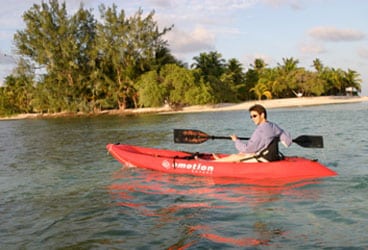
Herb McCormick The cruise director found solace in solitary kayaking expeditions around the atolls.
The Truth-Nothing But
Can you say “mood-swing critical mass”?
By Elaine Lembo
We were a multitude of personalities fit to fill a cruise ship: a pair of anglers, a former big-city most-eligible bachelor, a Cape Horner, a closet smoker, a crooner, a deep-sea diver, a jock, a man with jock itch, a swab, an old girl, a princess, a poet, a prima donna. And of course, no cruise is complete without a tour director.
Alas, we didn’t book the right boat. In fact, the four individuals into whom these sundry shades of behavior were stuffed found themselves shoehorned as crewmates aboard a 40-foot catamaran. I was one of them. This is my story, and I’m stickin’ to it.
Our cruising grounds were the southern cays and atolls of Belize, an often-overlooked Central American country whose border fronts on the western shores of the Caribbean Sea. Our mission, as it turns out, was to drive each other crazy while enjoying the carefree sailing, fishing, diving, kayaking, collegial meal making, and other wonderful aspects of bareboating that make such trips truly memorable for sailors just about everywhere.
We initially operated under the veneer of the personas that we usually present to each other. As the days of the week progressed and we sailed through the cays and offshore atolls, the real personalities emerged.
The jock and diver, it turns out, was also a stargazer, a frustrated cinematographer, and a road warrior in that he loved any kind of music that helps him put miles in the rearview mirror. Herb McCormick went nowhere without his trusty case of CDs. Also the Cape Horner, he likes to sail and was aces on the helm. As for his creative eye behind the lens, wherever we went, he was framing shots and talking into a video camera. The anglers soon named him Scorsese.
As for the pair of anglers, one of them-in fact, the one who’d frequently announce that nothing bothers him any more-was really a homesick father who doted on his wife and kids. No matter how stunning the sunset or clear the water, Angus Phillips’s guilt over not being with his son to help him move into his first home intensified as the days wore on. Yes, you guessed right, he was also the closet smoker, the crooner, and the poet. Early each morning, he entertained us with torch-song melodies from his cabin, including this one: “‘Emotions in my heart'”-pause-“‘are making me long for you. . . .'”
As morning blossomed into afternoon, the oratory shifted to poetry, a rhymed recitation of our actions at every juncture. The memory of all those ramblings lingers in a pleasing way.
The other angler, God bless Andrew Hughes’ soul, was all sunshine and optimism. The former big-city most-eligible bachelor’s heyday was past, and he was now another doting father, but one without separation anxiety-and his kid was still a toddler. This guy loved to fish and drink beer, and that was pretty much that. On countless occasions, he buoyed the mood. I repeat: God bless his soul.
Then there was me. This won’t be an accurate self-assessment, no matter what. I was swab, old girl, princess, prima donna. I was also the tour director, having come up with the idea for the trip and then planned it from soup to nuts. Hey, call me crazy. I am, now.
It all started out innocently enough: The provisions arrived at The Moorings base in the seaside village of Placenciaand right away the guys wanted to know why I’d ordered so much club soda and Diet Coke and so little beerand the CDs went into the player. Bingo. Instant party.
Partying aside, we did our bit, as directed, as responsible vacation sailors. We’d listened to and then carefully followed the instructions doled out by Cricket, a Moorings staffer who came aboard and guided us through the systems of Lisa Michelle, the Moorings 4000 that was our platform for this adventure. And we dutifully attended the skippers briefing, a two-hour marathon detailing possible itineraries as well as the dos and don’ts of the cruising grounds surrounding the base.
Base manager Renee Brown started out with a concept simple enough for any would-be old salt to comprehend: “The last marine survey done in Belize was in 1989,” she said. “There’ve been significant changes in the coast due to weather, mainly hurricanes. The most important navigational tool in Belize is your eyes on deck.”
Sail only, she continued, from 9 a.m. to 4 p.m. for best visibility among the shallows and reef patches. Stay on the alert for long fetches that would make an anchorage uncomfortable; choose mooring over anchoring, but always dive to examine the tackle; realize that the closer you sail to the barrier reef, the stronger the wind and the greater the groundswell. Watch out for the yellow stingrays, spiny sea urchins, crocodiles, Portuguese men-of-war, scorpions, boa constrictors, no-see-ums, and sand flies. “A tour inland gives you a chance to experience the other side of Belize,” she advised in conclusion.
After that laundry list of scary critters, an inland tour shot to the top of my wish list, and I cajoled the cinematographer to start off this sailing adventure in an air-conditioned van. We traveled by water and winding road about 85 miles inland to Lubaantun, an ancient Mayan city that archeologists first excavated in 1915. Our anglers were fine with this plan; one was awaiting lost luggage.
We arrived at the Lubaantun Archaeological Reserve, after a refreshing dip in the freshwater of Blue Creek, just in time to catch the tail end of the Toledo district’s 2008 Cacao Fest (www.toledochocolate.com), a community celebration whose aim is to raise awareness of the Belizean Mayan culture and promote local agriculture, specifically the harvesting of organic cacao to be used in the production of chocolate. Scorsese first squirmed at the girlishness of this inland tour, but once I gave him the video camera and he was able to turn the world into his own silver screen, he calmed down.
For my part, I enjoyed every second of it, including the colors of the costumes of the participants in the Deer Dance, the trinkets sold from the booths, and the local people themselves, many of whom live in thatch homes in tiny villages. I left wishing that I had more time to spend there. When we got back to the base, the former most-eligible bachelor had his luggage. All was well-so far.
The Moorings people set the right tone for this and all their charter excursions. Inside the base office, above the entry way to the chart-briefing room, is a clock. It tells time not in seconds, minutes, or hours but in days of the week. The underlying message, you might assume, is that in a little while, you will lose track, and you might not care that you lose track. It might actually evolve into a goal. It gave me pause about my tour-directing ways.
We managed to stay on point long enough to construct a loose itinerary that would allow us to cruise the southern area of the country, including the southernmost offshore atoll, Glover Reef, and then return by the end of the week refreshed and tanned.
At Glover, the anglers would stalk the shallows for bonefish, and Scorsese would join a rendezvous dive. I’d kayak, snorkel, and, if I really hit pay dirt, have a massage, but later I’d discover that there was no masseuse in residence where we’d sailed, and it mattered not, as swimming in this pristine and sparkling water went a long way to soothing my aches and pains.
Somewhere, somehow, along the way I should’ve seen the mood shifts coming. Before heading for the country’s offshore atolls, we were required to have a local skipper join our crew to guide us safely through the reef patches and the virtually unseen openings that occur along miles of mangrove. That in and of itself wasn’t the problem. The local skipper, Jimmy Westby, was one kool kat, and we had good enough reason to trust him with our lives. Hailing from Placencia, he was a lifelong fisherman and sailor, and so were members of his extended family. The Westbys knew these waters well and have long thrived from their bounty.
But when Jimmy guided the anglers away from waters teeming with bonefish for some undefined spot that lacked fish, cracks in the portrait of our happy family formed. Conspiracy theories mushroomed. “Never leave fish to go look for fish!” complained the crooner. Meanwhile, Scorsese not only found a good dive company but also a female dive master who caught his eye. If there was another dinner guest that night, he forewarned, he wanted no complaints. The crooner fell silent. As for me, I’d taken a liking to the kayak, intent on paddling alone until cocktail hour. A low profile, I thought, would be prudent.
I nearly achieved one, but any blissful notions I’d fostered that my solo exploits would remain private were shattered when I rounded a corner of the cay and ran smack-dab into the area where the anglers were ever so quietly continuing to scope out the elusive fish. Mortified that I’d ruined their chances, I offered apologies aplenty.
They caught no more fish that day or for the rest of the trip. The dive master was happily married, so Scorsese never scored. Jimmy cooked us a fine dinner from the gifts of land and sea, coconut rice and grilled conch. We had a lovely evening-until we realized that the kayak, a two-person model, had snapped its painter and drifted away.
By the time we bade Jimmy farewell near the southern tip of the mighty reef, some 48 hours after we picked him up, the crooner announced, “This trip’s over.” Then he asked to borrow my cellphone to call his family. Then he snapped at Scorsese for playing too much road music. Then, lest you think the dysfunction could not get headier, he talked about his garden and his tomato plants.
After nightfall, Scorsese and the former most-eligible bachelor partied their brains out, whooping it up on the foredeck trampoline. I couldn’t sleep. It made me even crankier about the piles of dirty dishes in the galley and the empty beer bottles in the cockpit. I gave them my darkest martyr-like scowl.
As it turned out, the one who had the final say about whether or not this trip was, in fact, over was Mother Nature herself. She’s the one who drenched the camera Scorsese left on deck one night, and she’s the one who entered stage left from the Pacific in the form of Pacific Tropical Storm Alma and, with enhanced convection, became Atlantic Tropical Storm Arthur. She’s the one who caused the catamaran to drag its anchor when Arthur first kicked up its heels, and she’s the one who ultimately made the base move all the boats, including ours, into the safety of a very buggy lagoon that was also a very good hurricane hole.
I’d say it’s her fault, too, that the crooner didn’t like the restaurant we’d picked for our last dinner together, forcing us to relocate to a bar with a big-screen TV so he and Scorsese could watch the Celtics in a playoff game. I pouted all night and shot them dagger-like stares. Our personality collisions had nearly reached critical mass, and they’d only converge completely and irretrievably when, upon being set ashore once and for all, Arthur poured rain on us and our cab was down the muddy road a ways. The crooner, my guess is, still hasn’t recovered from that one.
Dear reader, fear not. One mental image, clear as a bell, trumps all others and keeps my faith about such adventures intact. It is of me swinging in a multicolored hammock on the afternoon after we bid farewell to Jimmy. We’d caught a mooring, then gone ashore on Ranguana Cay. I was sipping a rum punch, and I was trying to retrace the itinerary and landfalls of the previous days. Were we at Tobacco Cay on Monday? Southwater Cay on Tuesday? Where had we sailed after that, and where had I caught my first yellowtail? Did we go directly to Glover Reef? Wait a minute. Where’d we just come from-this morning? I knew not, and for that, and every other memory lapse, I will always thank The Moorings and think of that briefing-room clock.
And as I lay in that hammock, swilling the local nectar, I realized that we’d had a “bad” and a “cranky” aboard, and we needed a “good.” Well I’m here to tell you, as a cruise director, that I was good. I was really good.
When not acting as cruise director, Elaine Lembo is CW’s deputy editor.
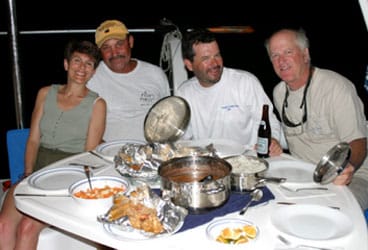
Herb McCormick

